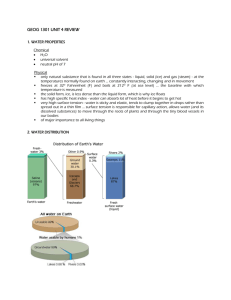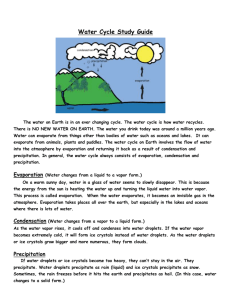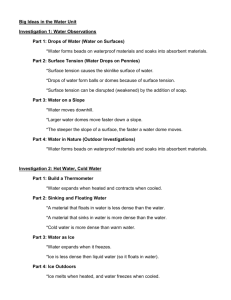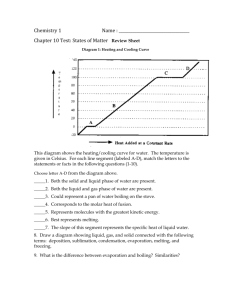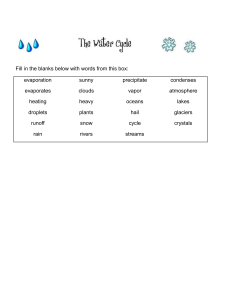12. Heat of melting and evaporation of water VS
advertisement
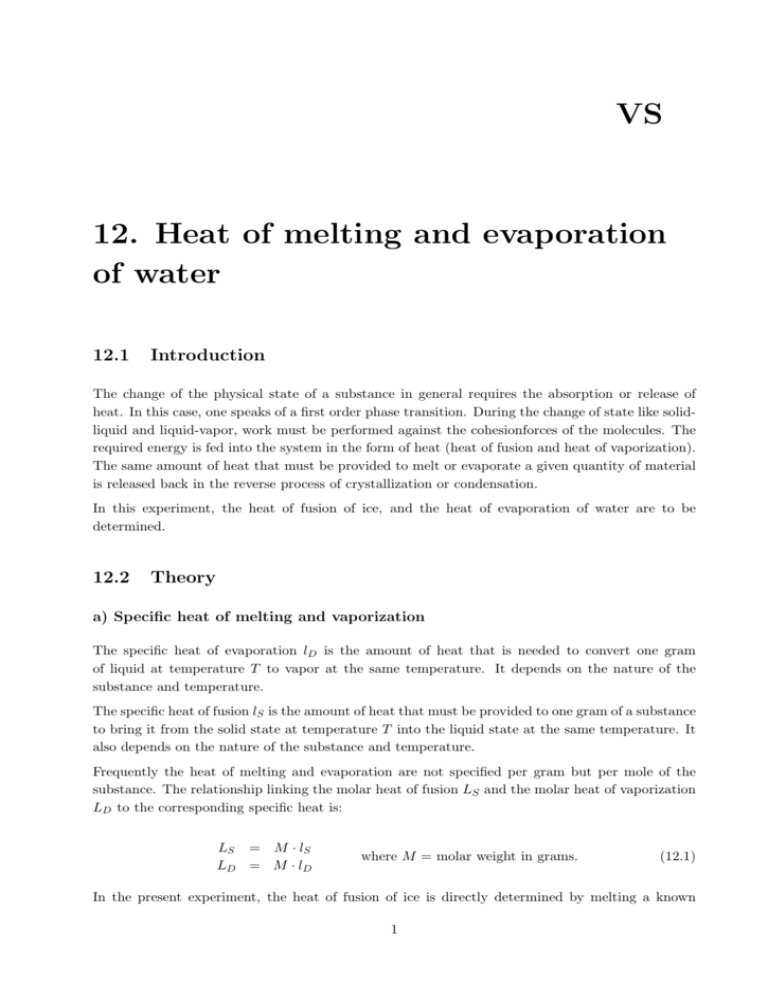
VS 12. Heat of melting and evaporation of water 12.1 Introduction The change of the physical state of a substance in general requires the absorption or release of heat. In this case, one speaks of a first order phase transition. During the change of state like solidliquid and liquid-vapor, work must be performed against the cohesionforces of the molecules. The required energy is fed into the system in the form of heat (heat of fusion and heat of vaporization). The same amount of heat that must be provided to melt or evaporate a given quantity of material is released back in the reverse process of crystallization or condensation. In this experiment, the heat of fusion of ice, and the heat of evaporation of water are to be determined. 12.2 Theory a) Specific heat of melting and vaporization The specific heat of evaporation lD is the amount of heat that is needed to convert one gram of liquid at temperature T to vapor at the same temperature. It depends on the nature of the substance and temperature. The specific heat of fusion lS is the amount of heat that must be provided to one gram of a substance to bring it from the solid state at temperature T into the liquid state at the same temperature. It also depends on the nature of the substance and temperature. Frequently the heat of melting and evaporation are not specified per gram but per mole of the substance. The relationship linking the molar heat of fusion LS and the molar heat of vaporization LD to the corresponding specific heat is: LS = M · lS LD = M · lD where M = molar weight in grams. (12.1) In the present experiment, the heat of fusion of ice is directly determined by melting a known 1 2 12. Heat of melting and evaporation of water amount of ice and measuring the amount of heat that is required to melt it. Due to vapor losses in evaporation experiments, the analog method for the determination of the heat of evaporation is less suitable. It is therefore determined indirectly from the temperature dependence of the vapor pressure. b) Measurement of the heat of fusion The heat of fusion of ice is to be determined by a mixing experiment. An amount mW of water at temperature T1 is merged with an amount mE of ice at temperature TE = 0◦ C. In the final stage (at thermodynamic equilibrium), the whole system has the same temperature TG . The amount Q of heat required to melt the ice and water and to bring the mixture to the temperature TG is: Q = mE · (lS + cW · (TG − TE )) (12.2) with TE = 0◦ C, where cW is the specific heat of water. The heat Q is drawn from the surrounding water and the container, that cool down from T1 to TG . The following relation applies: Q = (mW cW + W ) · (T1 − TG ) (12.3) Here, W is the known heat capacity of the container. It is initially unknown and must be measured in a separate experiment. Equating Eq. 12.2 and Eq. 12.3, we find the specific heat of fusion lS : lS = (mW cW + W ) · (T1 − TG ) − mE cW · (TG − TE ) mE (12.4) c) Determination of the heat of evaporation from the vapor pressure Vapor pressure above a liquid surface Consider a container filled with a volume V0 of a liquid (see Fig.. 12.1a). If the volume is increased without adding more liquid, then a portion of the liquid evaporates in order to fill the volume. In the new volume V1 , the substance therefore exists in the two phases, liquid and vapor, at the same time (coexistence, see Fig.. 12.1b). liquid a) V0 vapour liquid b) V1 vapour V2 liquid c) vapour V3 d) Figure 12.1: Liquid and vapor. The saturation pressure or vapor pressure pD is the pressure that is measured as soon as thermodynamic equilibrium is established between the gaseous and the liquid phase. If the piston is raised Laboratory Manuals for Physics Majors - Course PHY112/122 12.2. THEORY 3 further (Fig.. 12.1c), more and more fluid evaporates. If the increase in volume is isothermal (that is, at a constant temperature), then the vapor pressure remains constant until all of the liquid is evaporated (Fig.. 12.1d). The relationship between pressure p and volume V of a given system at a constant temperature T is represented by isotherms in the p − V diagram. Figure 12.2 shows a set of such isotherms for various temperatures according to the Van der Waals equation of state: a (V − b) · p + 2 = R · T. (12.5) V Within the range of coexistence of liquid and gas the values resulting from Eqn. 12.5 must be replaced by the vapor pressure pD (T ). The vapor pressure is constant in this p − V -representation and only depends on temperature as shown in Fig.. 12.2. p Tk pD(T2) T3 T1 T4 T2 V liquid coexistence liquid-gas gas Figure 12.2: Isotherms in p − V diagram for T1 < T2 < T3 < T4 < Tk . Determination of the heat of evaporation For a given substance, the vapor pressure pD , the heat of evaporation LD and the temperature T are related by a differential equation, the so-called equation of Clausius and Clapeyron: LD dpD = . dT T · (VD − VF l ) (12.6) Here, VD and VF l denote the molar volumes of the vapor and of the liquid at temperature T , respectively. Knowing the vapor pressure as a function of temperature, and the volumes VD and VF l the heat of evaporation can be calculated from Eqn. 12.6. For VD VF l , the Clausius-Clapeyron equation simplifies to: dpD LD = . dT T · VD Laboratory Manuals for Physics Majors - Course PHY112/122 (12.7) 4 12. Heat of melting and evaporation of water For the vapor and for low pressure the equation of state for ideal gases yields: VD = R·T , pD (12.8) where R = 8.3144 J/(K·mol) is the universal gas constant. This yields for the molar heat of vaporization dpD R · T 2 · dT pD (12.9) LD dT dpD = · . pD R T2 (12.10) LD = and thus If we neglect the small temperature dependence of LD (T ) for water in the range of temperature 0◦ C to 100◦ C, we obtain by integrating Eqn. 12.10 ln pD = − LD + const. R·T (12.11) Thus, if LD (T ) remains constant, as expected over the temperature range considered, the representation of ln(pD ) as a function of 1/T is a straight line, the slope of which can be used to determine the molar heat of vaporization LD . Laboratory Manuals for Physics Majors - Course PHY112/122 12.3. EXPERIMENTAL PART 12.3 5 Experimental part a) Measurement of the heat of fusion thermometer ice water dewar vessel Figure 12.3: Experimental arrangement The experimental arrangement used to determine the heat of fusion is shown in Fig.. 12.3. We use a well-insulating Dewar flask as container. In the container we mix an amount mW of water with an amount mE of ice at TE = 0◦ C. We measure the temperature TG when the thermal equilibrium is established, and we compute the specific heat of fusion of ice according to Eq. 12.4. The specific heat capacity of water can be assumed to be known: cW = 4.187 J/gK, and the heat capacity W of the container (including the stirrer and the thermometer) is determined in a mixing experiment with water. Determination of the heat capacity W of the dewar • Measure the weight of the empty the Dewar flask. Then fill it to approximately one half of the volume with hot tap water at a measured temperature TA . Determine the mass mA of the water by weighting the flask again. • Read the temperature of the water for 5 minutes every 30 seconds. • Now fill the Dewar flask with cold water at a measured temperature TB and determine mass mB of the cold water. • Mix the water well and check continuously that the temperatures in the center of the flask and on top of it are the same. • Read the temperature of the water for 5 minutes every 30 seconds. Laboratory Manuals for Physics Majors - Course PHY112/122 6 12. Heat of melting and evaporation of water • Plot all the measured values against time. Determine the effective initial value TA and the effective final value TG of the temperature by extrapolation, as shown in Fig.. 12.4. Make sure that the shaded areas above and below the measured curve are equal. • Determine the heat capacity of the container. During the experiment, the heat Q of the Dewar flask half filled with hot water was released, and it was absorbed by the cold water. Hence, the flask and hot water have cooled down from temperature TA to temperature TG , while the cold water has warmed up from temperature TB to TG . From the law of energy conservation follows: (mA cW + W ) · (TA − TG ) = mB cW · (TG − TB ) (12.12) and thus W = mB cW · TG − TB − mA cW TA − TG (12.13) T TA TA TG TG t Figure 12.4: Temperature curve for the determination of the heat capacity of the container Determination of the specific heat of fusion or this test, you can take ice cubes from the freezer in room 11-G-91 and eventually mince them. The ice cubes melt slower than crushed ice, so the temperature profile during melting can be measured better. The mixing process has in any case a very short duration, consider therefore well beforehand how you want to proceed when taking the measurement points. • Put the crushed ice (or ice cubes) for a few minutes in a container with tap water, until melting water forms. Then you can be sure that the ice has reached the temperature TE = 0◦ C. • Fill the Dewar flask to approximately one half with hot tap water at a measured temperature T1 . Determine the mass mW of the water. The hotter the water is, the higher temperature differences will occur during the experiment, and the more accurate the measurement will be. • Read the temperature of the water for 5 minutes every 30 seconds. Laboratory Manuals for Physics Majors - Course PHY112/122 12.3. EXPERIMENTAL PART 7 • Add a few ice cubes into the flask. The more ice you use, the higher temperature differences will occur. Stir well. • Read the temperature of the water for 5 minutes first every 5 seconds, then every 30 seconds. • At the end of the experiment, determine the mass mE of the melted ice by weighting the flask again. • Plot all the measured values against time. Determine the effective initial value TA and the effective final value TG of the temperature by extrapolation, as shown in Fig.. 12.5. Make sure that the shaded areas above and below the measured curve are equal. • Calculate the heat of fusion ls according to Eq. 12.4 (without error calculus). T T1 T1 TG TG t Figure 12.5: Temperature curve for the determination of the heat of fusion b)Determination of the heat of evaporation from the vapor pressure curve For this experiment we heat water in a pressure cooker. While it cools down, we record the vapor pressure curve and therefore determine the molar heat of evaporation of water. • Fill the pressure cooker with about 0.75 liters of water. • Heat the water until steam flows out of the valve of the pressure cooker. • Turn off the hot plate and read continuously, during the cooling down, the pressure and the temperature. Take at least 10 measurements in the pressure range from 1 to 2 atmospheres. • Draw in a first diagram the vapor pressure curve pD (T ), and in a second diagram draw ln pD as a function of 1/T . Express the temperature in Kelvin degrees. Find the straight line that best fits to the measured data points in the ln pD (1/T ) diagram. From the slope of this line, determine the molar heat of evaporation LD according to Eq. 12.11. Laboratory Manuals for Physics Majors - Course PHY112/122 8 12. Heat of melting and evaporation of water • Draw the error bars for the individual data points on the graph, and draw the steepest and the flattest straight lines compatible with the measurement errors. Compute from these slopes the error on LD (see Fig.. 12.6). ln pD G1 G2 G3 1/T Figure 12.6: Error on the slope of the line. Laboratory Manuals for Physics Majors - Course PHY112/122
